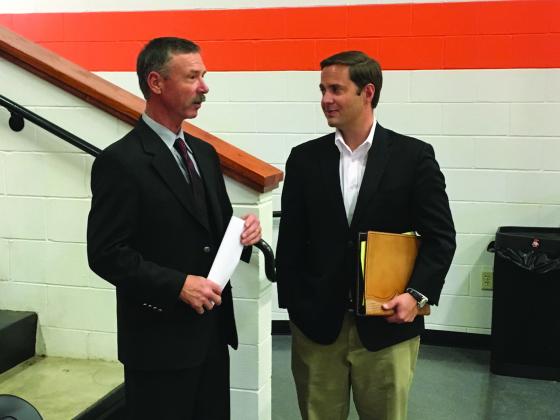Burrows learns how lack of state funding could hurt schools
With the Additional State Aid for Tax Reduction (ASATR) program scheduled to expire prior to the 2017-18 school year, officials with two Scurry County school districts told State Rep. Dustin Burrows, R-Lubbock, how it would affect them.
Burrows attended a meeting arranged by Ira ISD Superintendent Jay Waller on Wednesday inIra. Snyder ISD Superintendent Jim Kirkland also attended the meeting.
Waller said if ASATR funding is not provided, his district would lose $938,000. Kirkland said it would amount to $6.5 million for Snyder ISD.
To illustrate the importance of the funds, Waller said he would have to cut 19 of the 21 teaching positions to operate without the funding and Kirkland said it would amount to cutting half of Snyder’s teaching positions.
“This was eye-opening,” Burrows said after the meeting.
ASATR was established in 2006 to ensure no school district would see a loss of revenue caused by tax rate compression. ASATR serves as a bridge to help school districts achieve their target revenue and cover the loss of local property tax revenue.
In 2011, the legislature cut ASATR funding by 7.65 percent and revised the education code to repeal funding beginning with the 2017-18 school year.
Both Waller and Kirkland said cuts have been made in advance of the funding being stopped. But both superintendents said only so much can be done.
“We already have a very tight budget. Any loss of funding would hurt our students,” said Ira ISD Principal Dale Jones.
Kirkland said ASATR makes up 35 to 40 percent of Snyder’s budget.
“We have already started looking at the worst-case scenarios,” he said. “There is nothing you can do that won’t touch people or programs.”
Snyder ISD board of trustees president Ronnie Anderson said cutting all extra-curricular activities would only put a dent in the amount needed in order to educate students.
Burrows said after listening to the administrators that ASATR was a “heartburn issue.”
A lawsuit filed by school districts over state funding has not been decided. Burrows said that seems to be part of the problem because some lawmakers wanted to take a “wait-and-see” approach to funding during this year’s session.
“I would like to get it fixed. I don’t know if it will be done by the courts, during a special session (prior to the 2017 session) or during the 2017 session,” Burrows said. “I am for keeping ASATR or another funding formula.”
Burrows said he think the lawsuit will be decided in spring, but does not know if Gov. Greg Abbott would call a special session in order to address public education funding.
“If all you do is redistribute funding, you are hurting someone,” said Mike Mothereal, a public school district lobbyist and former superintendent at Sundown ISD.
Burrows said the 2017 session will see lawmakers deciding to move money from non-education programs to public education. He used spending millions for the film commission as an example of what could be moved to education.
“We are going to have to look at moving non-education funding to education,” he said.
Burrows said the state’s “rainy day fund” may also have to be tapped in order to help education funding.
“I think it is time we start using our savings account,” Anderson said.
“Whatever happens, there does not need to be any losers,” Mothereal said.
“If this place is not able to operate, this community is gone,” said Ira ISD board member William Cotton.
Waller said school district can find 10 percent to cut, but 30 to 40 percent in cuts is a different story.
“You just don’t find those kinds of cuts,” he said.
Burrows said both Snyder and Ira have spent ASATR money wisely and said the information provided was “real information.”
“I am going to take what I have learned today and start working the phones,” he said. “I wish we would not have left you with that anxiety.”
One temporary solution mentioned during the meeting was to cut unfunded state mandates. School officials said they would provide a list of those mandates to Burrows, who said he would study it and discuss it with other lawmakers.
“Another thing is to look at those folks who are underfunded,” Mothereal said. “There are a lot of them out there.”


